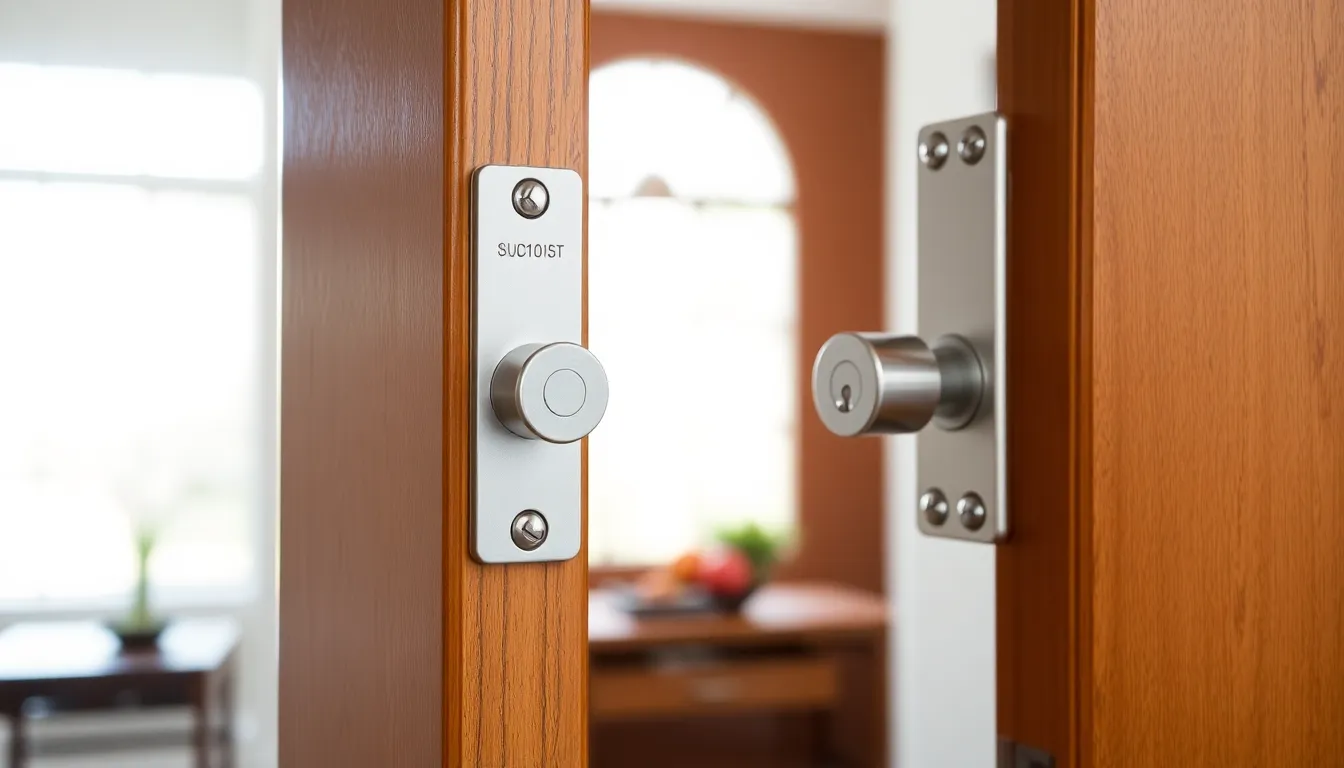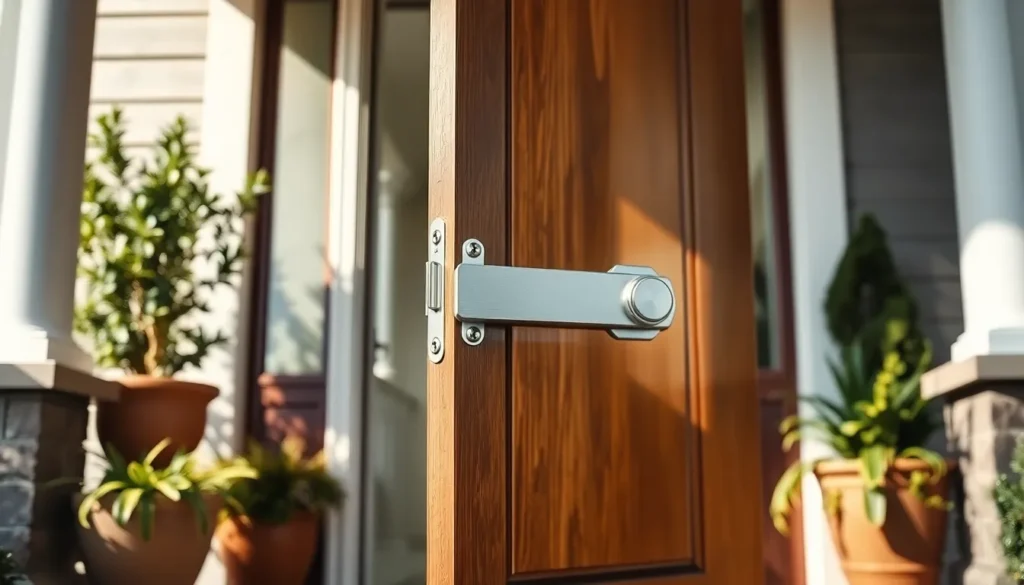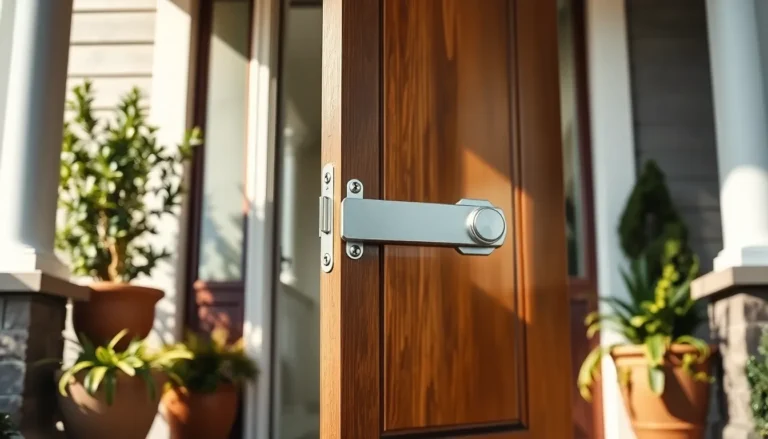Table of Contents
ToggleWhen it comes to home security, a solid door latch might not be the hero we deserve, but it’s certainly the unsung one. Just picture this: an intruder tries to sneak in, but they’re met with a stubborn door that won’t budge, thanks to an effective security latch. If that doesn’t put a grin on your face, nothing will. This guide will walk you through everything you need to know about door security latches, from understanding their function to maintaining them over time. After all, a secured home is a happy home, right?
Understanding Door Security Latches

Door security latches are the first line of defense against potential intruders. They serve as a simple yet effective locking mechanism that keeps doors shut and secure. At their core, latches work by engaging a bolt into a strike plate, preventing the door from opening unless the latch is manipulated. It’s a straightforward concept that offers peace of mind to homeowners everywhere.
Interestingly, understanding how a latch operates can illuminate the importance of selecting the right one. Think of it as the difference between riding a bicycle and driving a tank. One is great for leisurely strolls, while the other is a fortress on wheels. A quality latch acts much like that tank, offering robust security for your residential or commercial spaces.
Types of Door Security Latches
Not all door security latches are created equal. Here’s a rundown of the most common types:
1. Hook Latch
This latch features a hook that engages with the door frame. Its design allows for added strength and makes it difficult to pry open. Ideal for exterior doors, hook latches offer reliable security.
2. Slide Bolt Latch
Easy to operate, slide bolt latches offer a metal bolt that slides into place. While simple, they come in various designs, from basic to more complex mechanisms, enhancing security options.
3. Mortise Latch
A mortise latch is installed into a pocket cut into the door, providing clean aesthetics and the potential for higher security. Since it’s embedded within the door itself, it can be more resistant to tampering.
4. Surface-Mount Latch
For ease of installation, surface-mount latches are affixed to the door’s surface. They may lack the sleekness of mortise latches, but they make up for it with straightforward functionality.
Each type of latch serves unique purposes and security levels, so knowing their differences can help in making an well-informed choice.
How to Choose the Right Door Security Latch
Choosing the right door security latch involves assessing several factors:
1. Door Type and Material
Whether the door is wooden, metal, or fiberglass influences the latch style. Heavier doors may require more robust latching systems for optimal security.
2. Security Needs
If a homeowner lives in a high-crime area, investing in advanced latching mechanisms may be wise. Opt for latches featuring robust materials and tamper-resistant technology.
3. Aesthetics
While security is paramount, a latch should also complement the door’s design. Choose latches that blend functionality with style to create a cohesive look.
4. User Accessibility
Consider who will be using the latch. If young children or elderly family members will be accessing the door, ease of use should be a priority, making simpler mechanisms preferable.
Installation Tips for Door Security Latches
Installing a door security latch may seem daunting, but it can be straightforward with the right approach:
1. Gather Your Tools
You’ll need a measuring tape, screwdriver, and possibly a chisel depending on the latch type. Being well-prepared can save frustration down the line.
2. Measure Carefully
Precision is key. Measure the height at which you want to install the latch and mark it. Misalignments can lead to ineffective locking.
3. Follow Manufacturer Instructions
Each latch comes with specific instructions. Avoid improvising: following these can ensure proper functionality.
4. Test the Latch
Once installed, test the latch multiple times. It should open and close smoothly without excess force. Take notice of any wobble or misalignment and adjust as necessary to ensure security.
Maintaining Your Door Security Latch
Regular maintenance of door security latches is crucial for long-term performance:
1. Inspect Regularly
Routine checks can help catch wear and tear early. Look for rust, misalignment, or any signs of damage. If something doesn’t seem right, consider replacing the latch.
2. Lubrication
Give the latch a little TLC by applying a lubricant to keep the mechanism functioning smoothly. Avoid grease that can attract dust: a dry lubricant might be the best option.
3. Clean Surrounding Areas
Dust and debris can affect latch performance. Regularly wipe down the latch and surrounding areas to keep everything clean and operational.
Enhancing Security Beyond Latches
While latches are vital, they aren’t the only game in town when it comes to home security. Consider these additional measures:
1. Deadbolts
A deadbolt offers superior security compared to traditional latches. Installing deadbolts alongside latches provides an added layer of protection, making it much harder for intruders to gain access.
2. Security Cameras
Having a visual deterrent can significantly reduce the likelihood of break-ins. Security cameras not only document suspicious activity but also provide peace of mind.
3. Alarm Systems
An alarm system can notify homeowners of any attempts to breach security, alerting emergency services promptly. Combining this with latches leads to a robust security plan.





